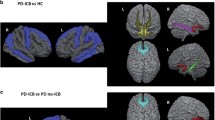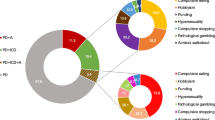Abstract
Patients with Parkinson’s disease (PD) have been suggested to share personality traits characterised by low novelty-seeking and high harm-avoidance. Although a link between novelty-seeking and dopamine is hypothesised, the link is not fully supported by 6-[18F]fluoro-l-dopa positron emission tomography (PET) studies. Meanwhile, tractography studies with magnetic resonance imaging (MRI) link personality to the connectivity of the striatum in healthy subjects. Here, we investigated neurochemical and anatomical correlates of characteristic personality traits in PD. Sixteen PD patients and 28 healthy controls were assessed using the Temperament and Character Inventory. All patients and 17 randomly selected controls were scanned with 2β-carbomethoxy-3β-(4-fluorophenyl)-[N-11C-methyl]tropane ([11C]CFT) PET to measure striatal dopamine transporter availability. All subjects were scanned with MRI to evaluate the connectivity of the striatum using probabilistic tractography. PET findings revealed no correlation of novelty-seeking and harm-avoidance with [11C]CFT uptake in patients or controls. Novelty-seeking correlated positively with the connectivity strength of the striatum with the hippocampus and amygdala in both patients and controls. Harm-avoidance and the fibre connectivity strength of the striatum including ventral area with the amygdala correlated negatively in patients and positively in controls, which differed significantly between the groups. Our data support the notion that the fibre connectivity of the striatum with limbic and frontal areas underlies the personality profile. Furthermore, our findings suggest that higher harm-avoidance in PD is linked to alterations of the network, including the nucleus accumbens and amygdala.



Similar content being viewed by others

References
Menza M (2000) The personality associated with Parkinson’s disease. Curr Psychiatry Rep 2(5):421–426. doi:10.1007/s11920-000-0027-1
Ishihara L, Brayne C (2006) What is the evidence for a premorbid parkinsonian personality: a systematic review. Mov Disord 21(8):1066–1072. doi:10.1002/mds.20980
Hernan MA, Takkouche B, Caamano-Isorna F, Gestal-Otero JJ (2002) A meta-analysis of coffee drinking, cigarette smoking, and the risk of Parkinson’s disease. Ann Neurol 52(3):276–284. doi:10.1002/ana.10277
Evans AH, Lawrence AD, Potts J, Appel S, Lees AJ (2005) Factors influencing susceptibility to compulsive dopaminergic drug use in Parkinson disease. Neurology 65(10):1570–1574. doi:10.1212/01.wnl.0000184487.72289.f0
Voon V, Thomsen T, Miyasaki JM, de Souza M, Shafro A, Fox SH, Duff-Canning S, Lang AE, Zurowski M (2007) Factors associated with dopaminergic drug-related pathological gambling in Parkinson disease. Arch Neurol 64(2):212–216. doi:10.1001/archneur.64.2.212
Cloninger CR, Svrakic DM, Przybeck TR (1993) A psychobiological model of temperament and character. Arch Gen Psychiatry 50(12):975–990. doi:10.1001/archpsyc.1993.01820240059008
Menza MA, Golbe LI, Cody RA, Forman NE (1993) Dopamine-related personality traits in Parkinson’s disease. Neurology 43(3 Pt 1):505–508. doi:10.1212/WNL.43.3_Part_1.505
Kaasinen V, Nurmi E, Bergman J, Eskola O, Solin O, Sonninen P, Rinne JO (2001) Personality traits and brain dopaminergic function in Parkinson’s disease. Proc Natl Acad Sci USA 98(23):13272–13277. doi:10.1073/pnas.231313198
Benjamin J, Li L, Patterson C, Greenberg BD, Murphy DL, Hamer DH (1996) Population and familial association between the D4 dopamine receptor gene and measures of novelty seeking. Nat Genet 12(1):81–84. doi:10.1038/ng0196-81
Ebstein RP, Novick O, Umansky R, Priel B, Osher Y, Blaine D, Bennett ER, Nemanov L, Katz M, Belmaker RH (1996) Dopamine D4 receptor (D4DR) exon III polymorphism associated with the human personality trait of novelty seeking. Nat Genet 12(1):78–80. doi:10.1038/ng0196-78
Menza MA, Mark MH, Burn DJ, Brooks DJ (1995) Personality correlates of [18F]dopa striatal uptake: results of positron-emission tomography in Parkinson’s disease. J Neuropsychiatry Clin Neurosci 7(2):176–179. doi:10.1176/jnp.7.2.176
Jacobs H, Heberlein I, Vieregge A, Vieregge P (2001) Personality traits in young patients with Parkinson’s disease. Acta Neurol Scand 103(2):82–87. doi:10.1034/j.1600-0404.2001.103002082.x
McNamara P, Durso R, Harris E (2008) Alterations of the sense of self and personality in Parkinson’s disease. Int J Geriatr Psychiatry 23(1):79–84. doi:10.1002/gps.1845
Kim MJ, Whalen PJ (2009) The structural integrity of an amygdala–prefrontal pathway predicts trait anxiety. J Neurosci 29(37):11614–11618. doi:10.1523/jneurosci.2335-09.2009
Cohen MX, Schoene-Bake JC, Elger CE, Weber B (2009) Connectivity-based segregation of the human striatum predicts personality characteristics. Nat Neurosci 12(1):32–34. doi:10.1038/nn.2228
Cloninger CR (1994) Temperament and personality. Curr Opin Neurobiol 4(2):266–273. doi:10.1016/0959-4388(94)90083-3
Barnes TD, Kubota Y, Hu D, Jin DZ, Graybiel AM (2005) Activity of striatal neurons reflects dynamic encoding and recoding of procedural memories. Nature 437(7062):1158–1161. doi:10.1038/nature04053
Graybiel AM (2008) Habits, rituals, and the evaluative brain. Annu Rev Neurosci 31:359–387. doi:10.1146/annurev.neuro.29.051605.112851
Kijima N, Saito R, Takeuchi M, Yoshino A, Ono Y, Kato M, Kitamura T (1996) Cloninger’s seven-factor model of temperament and character and Japanese version of Temperament and Character Inventory (TCI). Seishinka Shindangaku (Arch Psychiatr Diagn Clin Eval) 7(3):379–399
Poletti M, Bonuccelli U (2012) Personality traits in patients with Parkinson’s disease: assessment and clinical implications. J Neurol 259(6):1029–1038. doi:10.1007/s00415-011-6302-8
Tomlinson CL, Stowe R, Patel S, Rick C, Gray R, Clarke CE (2010) Systematic review of levodopa dose equivalency reporting in Parkinson’s disease. Mov Disord 25(15):2649–2653. doi:10.1002/mds.23429
Laakso A, Bergman J, Haaparanta M, Vilkman H, Solin O, Hietala J (1998) [18F]CFT [(18F)WIN 35,428], a radioligand to study the dopamine transporter with PET: characterization in human subjects. Synapse 28(3):244–250. doi:10.1002/(sici)1098-2396(199803)28:3<244:aid-syn7>3.0.co;2-a
Oguri T, Sawamoto N, Tabu H, Urayama S, Matsuhashi M, Matsukawa N, Ojika K, Fukuyama H (2013) Overlapping connections within the motor cortico-basal ganglia circuit: fMRI-tractography analysis. Neuroimage 78:353–362. doi:10.1016/j.neuroimage.2013.04.026
Patenaude B, Smith SM, Kennedy DN, Jenkinson M (2011) A Bayesian model of shape and appearance for subcortical brain segmentation. Neuroimage 56(3):907–922. doi:10.1016/j.neuroimage.2011.02.046
Smith SM, Jenkinson M, Woolrich MW, Beckmann CF, Behrens TE, Johansen-Berg H, Bannister PR, De Luca M, Drobnjak I, Flitney DE, Niazy RK, Saunders J, Vickers J, Zhang Y, De Stefano N, Brady JM, Matthews PM (2004) Advances in functional and structural MR image analysis and implementation as FSL. Neuroimage 23(Suppl 1):S208–S219. doi:10.1016/j.neuroimage.2004.07.051
Sawamoto N, Piccini P, Hotton G, Pavese N, Thielemans K, Brooks DJ (2008) Cognitive deficits and striato-frontal dopamine release in Parkinson’s disease. Brain 131(Pt 5):1294–1302. doi:10.1093/brain/awn054
Pirker W (2003) Correlation of dopamine transporter imaging with parkinsonian motor handicap: how close is it? Mov Disord 18(Suppl 7):S43–S51. doi:10.1002/mds.10579
Berrios GE, Campbell C, Politynska BE (1995) Autonomic failure, depression and anxiety in Parkinson’s disease. Br J Psychiatry 166(6):789–792. doi:10.1192/bjp.166.6.789
Di Giuda D, Camardese G, Bentivoglio AR, Cocciolillo F, Guidubaldi A, Pucci L, Bruno I, Janiri L, Giordano A, Fasano A (2012) Dopaminergic dysfunction and psychiatric symptoms in movement disorders: a 123I-FP-CIT SPECT study. Eur J Nucl Med Mol Imaging 39(12):1937–1948. doi:10.1007/s00259-012-2232-7
Pellecchia MT, Antonini A, Bonuccelli U, Fabbrini G, Ferini Strambi L, Stocchi F, Battaglia A, Barone P (2012) Observational study of sleep-related disorders in Italian patients with Parkinson’s disease: usefulness of the Italian version of Parkinson’s disease sleep scale. Neurol Sci 33(3):689–694. doi:10.1007/s10072-011-0826-7
Menza MA, Mark MH (1994) Parkinson’s disease and depression: the relationship to disability and personality. J Neuropsychiatry Clin Neurosci 6(2):165–169
Grucza RA, Przybeck TR, Spitznagel EL, Cloninger CR (2003) Personality and depressive symptoms: a multi-dimensional analysis. J Affect Disord 74(2):123–130. doi:10.1016/S0165-0327(02)00303-8
Elovainio M, Kivimaki M, Puttonen S, Heponiemi T, Pulkki L, Keltikangas-Jarvinen L (2004) Temperament and depressive symptoms: a population-based longitudinal study on Cloninger’s psychobiological temperament model. J Affect Disord 83(2–3):227–232. doi:10.1016/j.jad.2004.06.005
Farmer RF, Seeley JR (2009) Temperament and character predictors of depressed mood over a 4-year interval. Depress Anxiety 26(4):371–381. doi:10.1002/da.20459
Rinne JO, Bergman J, Ruottinen H, Haaparanta M, Eronen E, Oikonen V, Sonninen P, Solin O (1999) Striatal uptake of a novel PET ligand, [18F]beta-CFT, is reduced in early Parkinson’s disease. Synapse 31(2):119–124. doi:10.1002/(sici)1098-2396(199902)31:2<119:aid-syn4>3.0.co;2-o
Kaasinen V, Aalto S, Nagren K, Rinne JO (2004) Insular dopamine D2 receptors and novelty seeking personality in Parkinson’s disease. Mov Disord 19(11):1348–1351. doi:10.1002/mds.20191
Suhara T, Yasuno F, Sudo Y, Yamamoto M, Inoue M, Okubo Y, Suzuki K (2001) Dopamine D2 receptors in the insular cortex and the personality trait of novelty seeking. Neuroimage 13(5):891–895. doi:10.1006/nimg.2001.0761
Bodi N, Keri S, Nagy H, Moustafa A, Myers CE, Daw N, Dibo G, Takats A, Bereczki D, Gluck MA (2009) Reward-learning and the novelty-seeking personality: a between- and within-subjects study of the effects of dopamine agonists on young Parkinson’s patients. Brain 132(Pt 9):2385–2395. doi:10.1093/brain/awp094
Fried I, MacDonald KA, Wilson CL (1997) Single neuron activity in human hippocampus and amygdala during recognition of faces and objects. Neuron 18(5):753–765. doi:10.1016/S0896-6273(00)80315-3
Yamaguchi S, Hale LA, D’Esposito M, Knight RT (2004) Rapid prefrontal-hippocampal habituation to novel events. J Neurosci 24(23):5356–5363. doi:10.1523/jneurosci.4587-03.2004
Yang CR, Mogenson GJ (1987) Hippocampal signal transmission to the pedunculopontine nucleus and its regulation by dopamine D2 receptors in the nucleus accumbens: an electrophysiological and behavioural study. Neuroscience 23(3):1041–1055. doi:10.1016/0306-4522(87)90179-5
Schwartz CE, Wright CI, Shin LM, Kagan J, Rauch SL (2003) Inhibited and uninhibited infants “grown up”: adult amygdalar response to novelty. Science 300(5627):1952–1953. doi:10.1126/science.1083703
Kabbaj M, Devine DP, Savage VR, Akil H (2000) Neurobiological correlates of individual differences in novelty-seeking behavior in the rat: differential expression of stress-related molecules. J Neurosci 20(18):6983–6988
Amorapanth P, LeDoux JE, Nader K (2000) Different lateral amygdala outputs mediate reactions and actions elicited by a fear-arousing stimulus. Nat Neurosci 3(1):74–79. doi:10.1038/71145
LeDoux JE, Gorman JM (2001) A call to action: overcoming anxiety through active coping. Am J Psychiatry 158(12):1953–1955. doi:10.1176/appi.ajp.158.12.1953
Delgado MR, Jou RL, Ledoux JE, Phelps EA (2009) Avoiding negative outcomes: tracking the mechanisms of avoidance learning in humans during fear conditioning. Front Behav Neurosci 3:33. doi:10.3389/neuro.08.033.2009
Kringelbach ML, Rolls ET (2004) The functional neuroanatomy of the human orbitofrontal cortex: evidence from neuroimaging and neuropsychology. Prog Neurobiol 72(5):341–372. doi:10.1016/j.pneurobio.2004.03.006
O’Doherty J, Kringelbach ML, Rolls ET, Hornak J, Andrews C (2001) Abstract reward and punishment representations in the human orbitofrontal cortex. Nat Neurosci 4(1):95–102. doi:10.1038/82959
Haber SN, Kunishio K, Mizobuchi M, Lynd-Balta E (1995) The orbital and medial prefrontal circuit through the primate basal ganglia. J Neurosci 15(7 Pt 1):4851–4867
Richard JM, Berridge KC (2011) Nucleus accumbens dopamine/glutamate interaction switches modes to generate desire versus dread: D(1) alone for appetitive eating but D(1) and D(2) together for fear. J Neurosci 31(36):12866–12879. doi:10.1523/jneurosci.1339-11.2011
Floresco SB, Blaha CD, Yang CR, Phillips AG (2001) Dopamine D1 and NMDA receptors mediate potentiation of basolateral amygdala-evoked firing of nucleus accumbens neurons. J Neurosci 21(16):6370–6376
Stoessl AJ, Lehericy S, Strafella AP (2014) Imaging insights into basal ganglia function, Parkinson’s disease, and dystonia. Lancet 384(9942):532–544. doi:10.1016/s0140-6736(14)60041-6
Luo C, Song W, Chen Q, Zheng Z, Chen K, Cao B, Yang J, Li J, Huang X, Gong Q, Shang HF (2014) Reduced functional connectivity in early-stage drug-naive Parkinson’s disease: a resting-state fMRI study. Neurobiol Aging 35(2):431–441. doi:10.1016/j.neurobiolaging.2013.08.018
Sharman M, Valabregue R, Perlbarg V, Marrakchi-Kacem L, Vidailhet M, Benali H, Brice A, Lehericy S (2013) Parkinson’s disease patients show reduced cortical-subcortical sensorimotor connectivity. Mov Disord 28(4):447–454. doi:10.1002/mds.25255
Behrens TE, Johansen-Berg H, Woolrich MW, Smith SM, Wheeler-Kingshott CA, Boulby PA, Barker GJ, Sillery EL, Sheehan K, Ciccarelli O, Thompson AJ, Brady JM, Matthews PM (2003) Non-invasive mapping of connections between human thalamus and cortex using diffusion imaging. Nat Neurosci 6(7):750–757. doi:10.1038/nn1075
Behrens TE, Berg HJ, Jbabdi S, Rushworth MF, Woolrich MW (2007) Probabilistic diffusion tractography with multiple fibre orientations: What can we gain? Neuroimage 34(1):144–155. doi:10.1016/j.neuroimage.2006.09.018
Josefsson K, Jokela M, Cloninger CR, Hintsanen M, Salo J, Hintsa T, Pulkki-Raback L, Keltikangas-Jarvinen L (2013) Maturity and change in personality: developmental trends of temperament and character in adulthood. Dev Psychopathol 25(3):713–727. doi:10.1017/s0954579413000126
Lei X, Chen C, Xue F, He Q, Liu Q, Moyzis RK, Xue G, Cao Z, Li J, Li H, Zhu B, Liu Y, Hsu AS, Dong Q (2013) Fiber connectivity between the striatum and cortical and subcortical regions is associated with temperaments in Chinese males. Neuroimage 89C:226–234. doi:10.1016/j.neuroimage.2013.04.043
Acknowledgments
We thank S. Kawase, Division of Clinical Radiology Service, Kyoto University Hospital, for his expert help with PET scanning.
Author information
Authors and Affiliations
Corresponding author
Ethics declarations
All subjects provided written informed consent in accordance with the Declaration of Helsinki and the dictates of the Ethics Committee of Kyoto University Graduate School of Medicine prior to their inclusion in the study. All experimental protocol and relevant issues of the study were approved by the Ethics Committee of Kyoto University Graduate School of Medicine.
Conflicts of interest
On behalf of all authors, the corresponding author states that there is no conflict of interest.
Electronic supplementary material
Below is the link to the electronic supplementary material.
Rights and permissions
About this article
Cite this article
Ishii, T., Sawamoto, N., Tabu, H. et al. Altered striatal circuits underlie characteristic personality traits in Parkinson’s disease. J Neurol 263, 1828–1839 (2016). https://doi.org/10.1007/s00415-016-8206-0
Received:
Revised:
Accepted:
Published:
Issue Date:
DOI: https://doi.org/10.1007/s00415-016-8206-0



